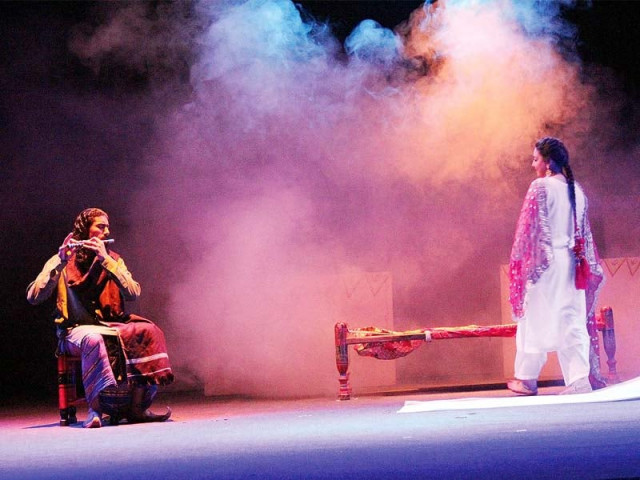Akhiyan: the vision of love
Azad Theatre’s play portrays a blind village girl harbouring the desire to witness societal insensitivity.

An out-and-out Punjabi play, Akhiyan features music and dance to carry the story forward. PHOTO: PUBLICITY
Until now, the National Academy of Performing Arts (Napa) International Theatre Festival has staged mostly experimental plays by international artists but on Thursday, the audiences were treated to parallel theatre with Azad Theatre’s Punjabi play Akhiyan.
Directed by Malik Aslam, the play is a stage adaptation of the 1930 made-for-radio production written by Rafi Peer. The play revolves around the travails of a blind village girl, who seeks the sense of sight, hoping to see herself and the world around her through her own eyes. Begum (Aaliya Abbasi) deals with one blow after another in life. Not only is she visually-impaired but also has also been forced into a marriage with a drug-addict.
Her chacha (Sarfraz Ansari) is shown to be against the union from the beginning, as he has been Begum’s caretaker since she was a child. The next scene shows Begum talking to another woman, Nooriye (Rabia Butt), narrating her life’s tragic tale and how she still harbours the desire to see, so that she can witness the society’s insensitivity.
Explaining Begum’s character and the play’s thematic significance, Aslam said, “The theme of the play is simple: the real thing in life is love. The character of Begum is meant to show that the real roshni in this world is that of love.” He added, “If there is love in your life, then despite a person’s blindness, he or she will still have hope, knowing that not everything around him is dark and that there is some light in his life.”

Throughout the play, Begum is seen to be carrying a chained Swiss army knife to protect herself from nightmares. According to Aslam, Begum’s character is a representation of one’s “inner and outer self” and the chained knife was a symbol of how she, like other women in this part of the world, is being tied down by society. “Although blind on the outside, she uses the chained knife to stop the suffering in her life and fight for her rights,” he said.
An out-and-out Punjabi play, Akhiyan features music and dance to carry the story forward, with one telling sequence in particular, where a person clad in white dances on the stage with a knife in hand to depict Begum murdering her oppressive husband and eventually committing suicide.
While talking about the choice of music and art direction with regards to the performance, cast member and the play’s music producer Sarfraz Ansari said the reason they decided to combine these different styles was because they were experimenting with a new technique of production and scripting.
Aslam feels the reason audiences may see an amalgamation of different styles of music and dance is because the play was scripted during pre-partition days. “The play was written almost 75 years ago and to present it for audiences in this day and age, we had to make it more visually-engaging while keeping it relevant to our culture,” remarked the director.
Despite the adaptation, Aslam tried to stay true to the original version and worked closely with his art director to ensure that translates on to the set design. “You can see this in our usage of long curtains, which is a frequent feature in British plays. We have used them in certain sequences and tried to present the quintessential British technique in a local style,” he said.
Published in The Express Tribune, March 22nd, 2015.
Like Life & Style on Facebook, follow @ETLifeandStyle on Twitter for the latest in fashion, gossip and entertainment.



















COMMENTS
Comments are moderated and generally will be posted if they are on-topic and not abusive.
For more information, please see our Comments FAQ